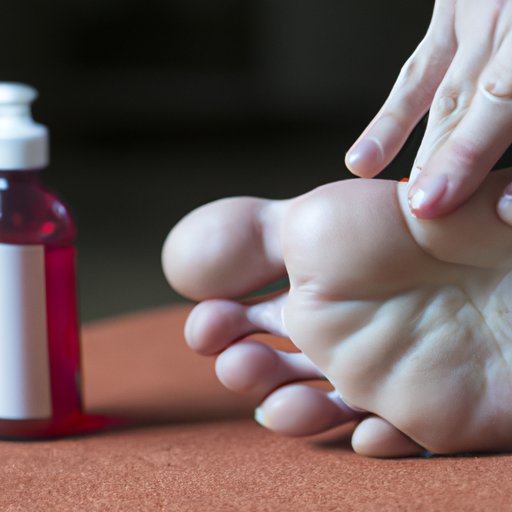
Introduction
Athlete’s foot is a common fungal infection that affects millions of people worldwide. It can be painful, itchy, and cause embarrassment for many. Although it’s easily treatable, it can be challenging to get rid of if left untreated. In this article, we’ll explore the causes, symptoms, and most effective ways to eliminate athlete’s foot while providing helpful tips to avoid recurrence.
Understanding Athlete’s Foot
Athlete’s foot, medically known as tinea pedis, is a fungal infection that commonly affects the feet. It thrives in warm, moist environments like locker rooms, public showers, and swimming pools. It can also be spread through contact with an infected person or by sharing personal items like shoes, socks, and towels.
Causes and Symptoms of Athlete’s Foot
Athlete’s foot is caused by various types of fungi, including Trichophyton, Epidermophyton, and Microsporum. These fungi feed on keratin, a protein found in hair, nails, and skin, causing the skin on the feet to become scaly, red, and itchy. Symptoms include flaking skin, cracked, blistered, or peeling skin, itching, burning, and stinging sensations. The infection can also spread to the toenails, causing them to thicken and become discolored.
Common misconceptions related to athlete’s foot
Many misconceptions surround athlete’s foot, making it challenging to treat. Here are a few common ones:
- Athlete’s foot only occurs in athletes – False
- Athlete’s foot is contagious – True
- Athlete’s foot affects only men – False
- Athlete’s foot disappears on its own – False
Ways to Eliminate Athlete’s Foot
Over-the-Counter Antifungal Creams
Over-the-counter antifungal creams like miconazole, terbinafine, and clotrimazole are effective for eliminating athlete’s foot. Apply the cream directly on the affected area once or twice a day for one to four weeks, depending on the severity of the infection. Ensure to continue applying the cream for at least two weeks after the symptoms disappear to prevent recurrence.
Keeping Feet Clean and Dry
Keeping your feet clean and dry is essential in eliminating and preventing athlete’s foot. Wash your feet daily with warm, soapy water, rinse, and dry them thoroughly, especially between the toes. Avoid using the same towel multiple times and make sure your feet are entirely dry before wearing socks or shoes.
Using Antifungal Powder
Antifungal powder like talcum powder or zeasorb can help keep your feet dry and prevent the growth of fungi. Apply the powder on your feet before putting on socks or shoes for the best results.
Avoiding Sharing of Personal Items
Avoid sharing personal items like shoes, socks, and towels with anyone to prevent the spread of the infection. If you have athlete’s foot, ensure to wear shoes or sandals in public showers or pools to avoid spreading the fungus to others.
Wearing Shoes in Public Areas
Athlete’s foot is contagious and can be contracted from public areas like showers, pools, gyms, and locker rooms. Ensure to wear shoes or sandals to mitigate the risk of infection.
Using Tea Tree Oil
Tea tree oil has natural antifungal properties, making it an effective treatment for athlete’s foot. Dilute two drops of tea tree oil in a tablespoon of carrier oil and apply directly to the affected area once a day. Repeat for 7-10 days or until the symptoms disappear.
When to See a Doctor
If your symptoms persist or worsen after a week of home treatment, contact your healthcare provider. They may prescribe stronger antifungal medication or suggest further tests to determine whether your symptoms are caused by another condition.
Lifestyle Changes to Help Prevent Athlete’s Foot
Keep Feet Clean and Dry
Preventing athlete’s foot is all about keeping your feet clean and dry. Ensure to wash them daily with warm, soapy water, rinse, and dry them thoroughly, especially between the toes. You may also use a hairdryer on a low, cool setting to dry your feet.
Wear Moisture-Wicking Socks and Breathable Shoes
Wear socks made of breathable materials like cotton and bamboo to keep your feet dry. Avoid socks made of synthetic materials or fabrics that trap moisture. Shoes made of leather or mesh are also excellent choices for keeping your feet dry.
Use Sandals or Flip-Flops Outside Home
Wearing sandals or flip-flops outside home helps prevent the spread of fungi in public areas like swimming pools, showers, and locker rooms.
Regularly Disinfect High-Risk Surfaces
The fungi that cause athlete’s foot can survive outside of the body on surfaces like towels, carpets, and shoes. Ensure to disinfect high-risk surfaces daily to mitigate the risk of infection. Use a combination of vinegar and water solution, bleach solution, or other disinfectants recommended by healthcare professionals.
Conclusion
Recap of tips to get rid of athlete’s foot
Athlete’s foot can be eliminated using over-the-counter antifungal creams, keeping feet clean and dry, using antifungal powder, avoiding sharing personal items, wearing shoes in public areas, and using tea tree oil. In addition to getting rid of athlete’s foot, taking preventive measures like regular foot hygiene, wearing moisture-wicking socks and breathable shoes, using sandals or flip-flops outside the home, and regularly disinfecting high-risk surfaces can help prevent recurrence.
Importance of maintaining good foot hygiene
Maintaining good foot hygiene is crucial in eliminating and preventing athlete’s foot. Ensure to follow the lifestyle changes discussed in this article and see a healthcare provider if symptoms persist or worsen. With proper treatment and preventive measures, athlete’s foot can be a thing of the past.




